Spatial Distribution Characteristics and Sustainable Inheritance Strategies of National Traditional Fine Arts Intangible Cultural Heritage in China
Abstract
1. Introduction
2. Materials and Methods
2.1. Data Introduction
2.2. Research Methods
2.2.1. Nearest Neighbor Index
2.2.2. Moran’s I index
2.2.3. Nuclear Density Analysis Method
2.2.4. Geographical Concentration and Imbalance Index
3. Results and Analysis
3.1. Analysis of the Overall Spatial Distribution of the ICHA Projects
3.1.1. Spatial Distribution Pattern
3.1.2. Spatial Distribution Correlation
3.1.3. Spatial Kernel Density Analysis
3.2. Analysis of Characteristics of ICHA Projects with Different Factors
3.2.1. Analysis of Characteristics of ICHA Projects with Different Factors
3.2.2. Analysis of ICHA Project Data at Various Classification Levels
3.2.3. Nuclear Density and Data Analysis of Various Cultural Zones
3.2.4. Spatial Distribution and Data Analysis of Each Province
3.2.5. Nuclear Density and Data Analysis of ICHA Project Ethnicity
3.3. Analysis of Characteristics of ICHA Project Inheritors with Different Factors
3.3.1. Analysis of the Inheritor’s Project Details
3.3.2. Ethnic Analysis of ICHA Project Inheritors
3.3.3. Nuclear Density Analysis of ICHA Project Inheritors
3.3.4. Nuclear Densities and Data Analysis for Projects without Legacies
3.4. Analysis of Sustainable Inheritance Strategies
3.4.1. Education Drives the Sustainable Inheritance of ICHA
3.4.2. Tourism Drives the Sustainable Inheritance of ICHA
3.4.3. Modern Technology and Innovation
3.4.4. Cross-Regional Cooperation and Exchange
3.4.5. Legacy Support and Incentives
3.4.6. International Cooperation and Promotion
4. Discussion
4.1. Overall Spatial Distribution of ICHA Projects
4.2. Characteristics of ICHA Projects with Different Factors
4.3. Characteristics of ICHA Project Inheritors with Different Factors
4.4. Sustainable Inheritance Strategy
5. Conclusions
Author Contributions
Funding
Institutional Review Board Statement
Informed Consent Statement
Data Availability Statement
Conflicts of Interest
References
- Unesco. The Convention for the Safeguarding of Intangible Cultural Heritage. In Proceedings of the 32th Session General Conference, Paris, France, 17 October 2003. [Google Scholar]
- Song, X.; Yang, Y.; Yang, R.; Shafi, M. Keeping Watch on Intangible Cultural Heritage: Live Transmission and Sustainable Development of Chinese Lacquer Art. Sustainability 2019, 11, 3868. [Google Scholar] [CrossRef]
- Kuang, R.; Zuo, Y.; Gao, S.; Yin, P.; Wang, Y.; Zhang, Z.; Cai, S.; Li, N. Research on the Spatial Distribution Characteristics and Influencing Factors of Central China’s Intangible Cultural Heritage. Sustainability 2023, 15, 5751. [Google Scholar] [CrossRef]
- Petronela, T. The Importance of the Intangible Cultural Heritage in the Economy. Procedia Econ. Financ. 2016, 39, 731–736. [Google Scholar] [CrossRef]
- Sun, C.; Chen, H.; Liao, R. Research on Incentive Mechanism and Strategy Choice for Passing on Intangible Cultural Heritage from Masters to Apprentices. Sustainability 2021, 13, 5245. [Google Scholar] [CrossRef]
- Chen, Q.; Ling, S.P. Analysis on the Spatial Distribution Characteristics and Influencing Factors of China’s Intangible cultural heritage. J. Geogr. Sci. 2013, 33, 1166–1172. [Google Scholar]
- Fatorić, S.; Seekamp, E. Securing the Future of Cultural Heritage by Identifying Barriers to and Strategizing Solutions for Preservation under Changing Climate Conditions. Sustainability 2017, 9, 2143. [Google Scholar] [CrossRef]
- Härkönen, E.; Huhmarniemi, M.; Jokela, T. Crafting Sustainability: Handcraft in Contemporary Art and Cultural Sustainability in the Finnish Lapland. Sustainability 2018, 10, 1907. [Google Scholar] [CrossRef]
- Aral, A.E. Seeing the glass half-empty: Implications for safeguarding intangible cultural heritage through formal education in Türkiye. Int. J. Herit. Stud. 2022, 28, 1286–1299. [Google Scholar] [CrossRef]
- Grammatikopoulou, A.; Laraba, S.; Sahbenderoglu, O.; Dimitropoulos, K.; Douka, S.; Grammalidis, N. An Adaptive Framework for the Creation of Exergames for Intangible Cultural Heritage (ICH) Education. J. Comput. Educ. 2019, 6, 417–450. [Google Scholar] [CrossRef]
- Su, J. Managing Intangible Cultural Heritage in the Context of Tourism: Chinese Officials’ Perspectives. J. Tour. Cult. Chang. 2020, 18, 164–186. [Google Scholar] [CrossRef]
- Goh, S.; Yeoman, I.S. Intangible Heritage, and Future Past of Rural Vietnam: A Hero’s Journey and Creative Place-Making of Yen Tu’s Tourism. J. Tour. Futures 2020, 7, 216–225. [Google Scholar] [CrossRef]
- Halder, S.; Sarda, R. Promoting Intangible Cultural Heritage (ICH) Tourism: Strategy for Socioeconomic Development of Snake Charmers (India) through Geoeducation, Geotourism and Geoconservation. Int. J. Geoheritage Parks 2021, 9, 212–232. [Google Scholar] [CrossRef]
- Dong, B.; Bai, K.; Sun, X.; Wang, M.; Liu, Y. Spatial Distribution and Tourism Competition of Intangible Cultural Heritage: Take Guizhou, China as an Example. Herit. Sci. 2023, 11, 64. [Google Scholar] [CrossRef]
- Chang, B.; Ding, X.; Xi, J.; Zhang, R.; Lv, X. Spatial-Temporal Distribution Pattern and Tourism Utilization Potential of Intangible Cultural Heritage Resources in the Yellow River Basin. Sustainability 2023, 15, 2611. [Google Scholar] [CrossRef]
- Chen, J.; Guo, Z.; Xu, S.; Law, R.; Liao, C.; He, W.; Zhang, M. A Bibliometric Analysis of Research on Intangible Cultural Heritage Tourism Using CiteSpace: The Perspective of China. Land 2022, 11, 2298. [Google Scholar] [CrossRef]
- The General Office of the State Council of the People’s Republic of China. Opinions on Enhancing Preservation of Intangible Cultural Heritage. Available online: http://www.gov.cn/gongbao/content/2005/content_63227.htm (accessed on 26 November 2022).
- Order of the President of the People’s Republic of China. Law of the People’s Republic of China on Intangible Cultural Heritage. Available online: http://www.npc.gov.cn/zgrdw/huiyi/lfzt/fwzwhycbhf/2011-05/10/content_1729844.htm (accessed on 26 November 2022).
- Wu, Q.; Li, X.G.; Zhang, M. Spatial distribution and causes of different types of Intangible cultural heritage in China. J. Geogr. Sci. 2015, 35, 175–183. [Google Scholar]
- Yang, J.; Wang, L.; Wei, S. Spatial Variation and Its Local Influencing Factors of Intangible Cultural Heritage Development along the Grand Canal in China. Int. J. Environ. Res. Public Health 2023, 20, 662. [Google Scholar] [CrossRef] [PubMed]
- Wang, J.; Chen, M.; Zhang, H.; Ye, F. Intangible Cultural Heritage in the Yangtze River Basin: Its Spatial Distribution Characteristics and Influencing Factors. Sustainability 2023, 15, 7960. [Google Scholar] [CrossRef]
- Pang, L.; Wu, L. Distribution Characteristics and Influencing Factors of Intangible Cultural Heritage in Beijing-Tianjin-Hebei. Herit. Sci. 2023, 11, 19. [Google Scholar] [CrossRef]
- Li, X.; Yang, M.; Long, L.; Liu, M.; Liu, H.; Liu, J. Geographical Distribution and Influencing Factors of Intangible Cultural Heritage in the Three Gorges Reservoir Area. Sustainability 2023, 15, 3025. [Google Scholar] [CrossRef]
- Nie, X.; Xie, Y.; Xie, X.; Zheng, L. The Characteristics and Influencing Factors of the Spatial Distribution of Intangible Cultural Heritage in the Yellow River Basin of China. Herit. Sci. 2022, 10, 121. [Google Scholar] [CrossRef]
- Li, W.; Jiao, J.; Qi, J.; Ma, J. The spatial and temporal differentiation characteristics of cultural heritage in the Yellow River Basin. PLoS ONE 2022, 17, e0268921. [Google Scholar] [CrossRef] [PubMed]
- Zhang, X.; Xiang, H.; Liu, R. Spatial Pattern and Influencing Factors of Intangible Cultural Heritage of Music in Xiangxi, Central China. Herit. Sci. 2022, 10, 39. [Google Scholar] [CrossRef]
- Nie, X.; Ma, M.; Ji, J.; Zheng, L. The Spatial Distribution of Traditional Intangible Cultural Heritage Medicine of China and Its Influencing Factors. Herit. Sci. 2023, 11, 90. [Google Scholar] [CrossRef]
- China Intangible Cultural Heritage Network. Available online: https://www.ihchina.cn/project#target1 (accessed on 1 August 2023).
- Ma, B.B. Spatial distribution, type structure, and influencing factors of key rural tourism villages in China. J. Geogr. Sci. 2020, 40, 190–199. [Google Scholar]
- Qin, D.S. Auto correlation analysis of quantitative indicators for forest spatial structure based on Moran’s I. For. Reso. Manag. 2020, 01, 8–17. [Google Scholar]
- Zha, W.D.; Zhang, D. Inheritance of Traditional Skills in a Skilled Society: Taking Suzhou Embroidery as an Example. Vocat. Educ. Forum 2023, 39, 29–36. [Google Scholar]
- Shide, Z.; Hongbin, G.; Yuanwang, W. Ecological environment and traditional craft: Taking Huizhou three carvings as an example. Anthropologist 2015, 21, 80–88. [Google Scholar] [CrossRef]
- Liu, H. Digital expression and inheritance of the intangible cultural heritage “Regong Art”. In Proceedings of the 2014 IEEE Workshop on Advanced Research and Technology in Industry Applications (WARTIA), Ottawa, ON, Canada, 29–30 September 2014; pp. 172–174. [Google Scholar] [CrossRef]
- Luo, Q.; Xu, X.; Gao, H. Research on the Inheritance of Miao Costume Culture Based on Digital Wireless Communication Technology. Mob. Inf. Syst. 2022, 2022, 4052341. [Google Scholar] [CrossRef]
- Chen, L.; Su, Z.; He, X. The application of robotics and artificial intelligence in embroidery: Challenges and benefits. Assem. Autom. 2022, 42, 851–868. [Google Scholar] [CrossRef]
- Han, H.J.; Oh, H.J.; Kim, Y. A study on the construction and utilization of digital archives for intangible cultural heritage in Korea. J. Korean BIBLIA Soc. Libr. Inf. Sci. 2016, 27, 95–134. [Google Scholar] [CrossRef][Green Version]
- Dou, J.; Qin, J.; Jin, Z.; Li, Z. Knowledge Graph Based on Domain Ontology and Natural Language Processing Technology for Chinese Intangible Cultural Heritage. J. Visual. Lang. Comput. 2018, 48, 19–28. [Google Scholar] [CrossRef]
- Xu, B.C.; Pan, J.H. Spatial distribution characteristics and influencing factors of China’s national Intangible cultural heritage. Econ. Geogr. 2018, 38, 188–196. [Google Scholar]
- Maurer-Fazio, M.; Hasmath, R. The Contemporary Ethnic Minority in China: An Introduction. Eurasian Geogr. Econ. 2015, 56, 1–7. [Google Scholar] [CrossRef]
- Terkenli, T.S.; Georgoula, V. Tourism and Cultural Sustainability: Views and Prospects from Cyclades, Greece. Sustainability 2022, 14, 307. [Google Scholar] [CrossRef]
- Xiao, J.; Wu, Y.; Wang, M.; Zhao, Y. Using Choice Experiments to Assess Tourist Values for Intangible Cultural Heritage—The Case of Changdao Fishermen’s Work Song in China. J. Cult. Herit. 2023, 60, 50–62. [Google Scholar] [CrossRef]
- Tan, S.-K.; Tan, S.-H.; Kok, Y.-S.; Choon, S.-W. Sense of Place and Sustainability of Intangible Cultural Heritage—The Case of George Town and Melaka. Tourism. Manag. 2018, 67, 376–387. [Google Scholar] [CrossRef]
- Hou, Y.; Kenderdine, S.; Picca, D. Digitizing intangible cultural heritage embodied: State of the art. J. Comput. Cult. Herit. 2022, 15, 1–20. [Google Scholar] [CrossRef]
- Rodil, K. A perspective on systems design in the digitisation of Intangible Cultural Heritage. Int. J. Intang. Herit. 2017, 12, 190–198. Available online: https://vbn.aau.dk/en/publications/a-perspective-on-systems-design-in-the-digitisation-of-intangible (accessed on 1 August 2023).
- Wang, C. Building a Network for Preserving Intangible Cultural Heritage through Education: A Study of Indonesian Batik. Int. J. Art. Des. Educ. 2019, 38, 398–415. [Google Scholar] [CrossRef]
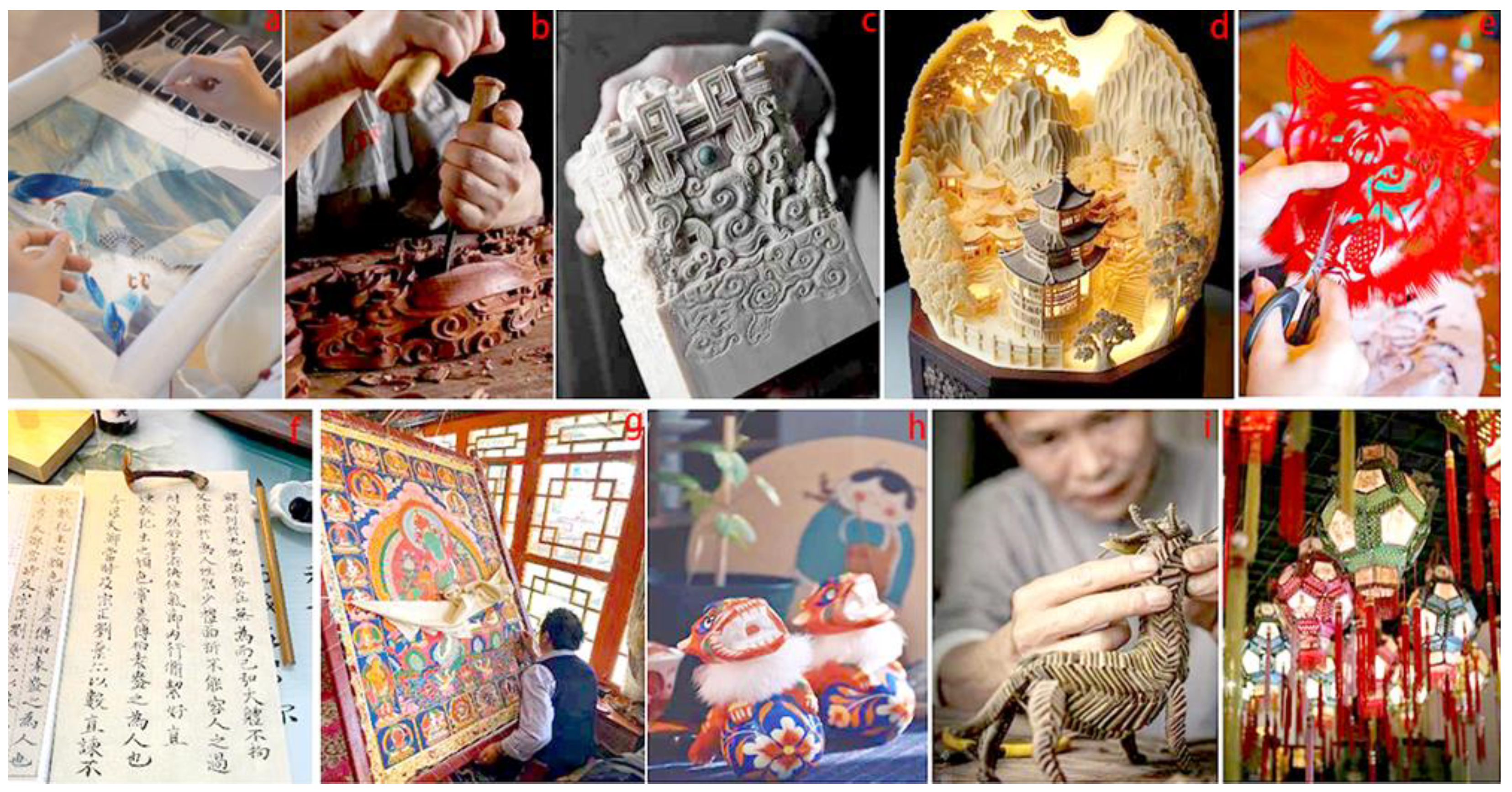
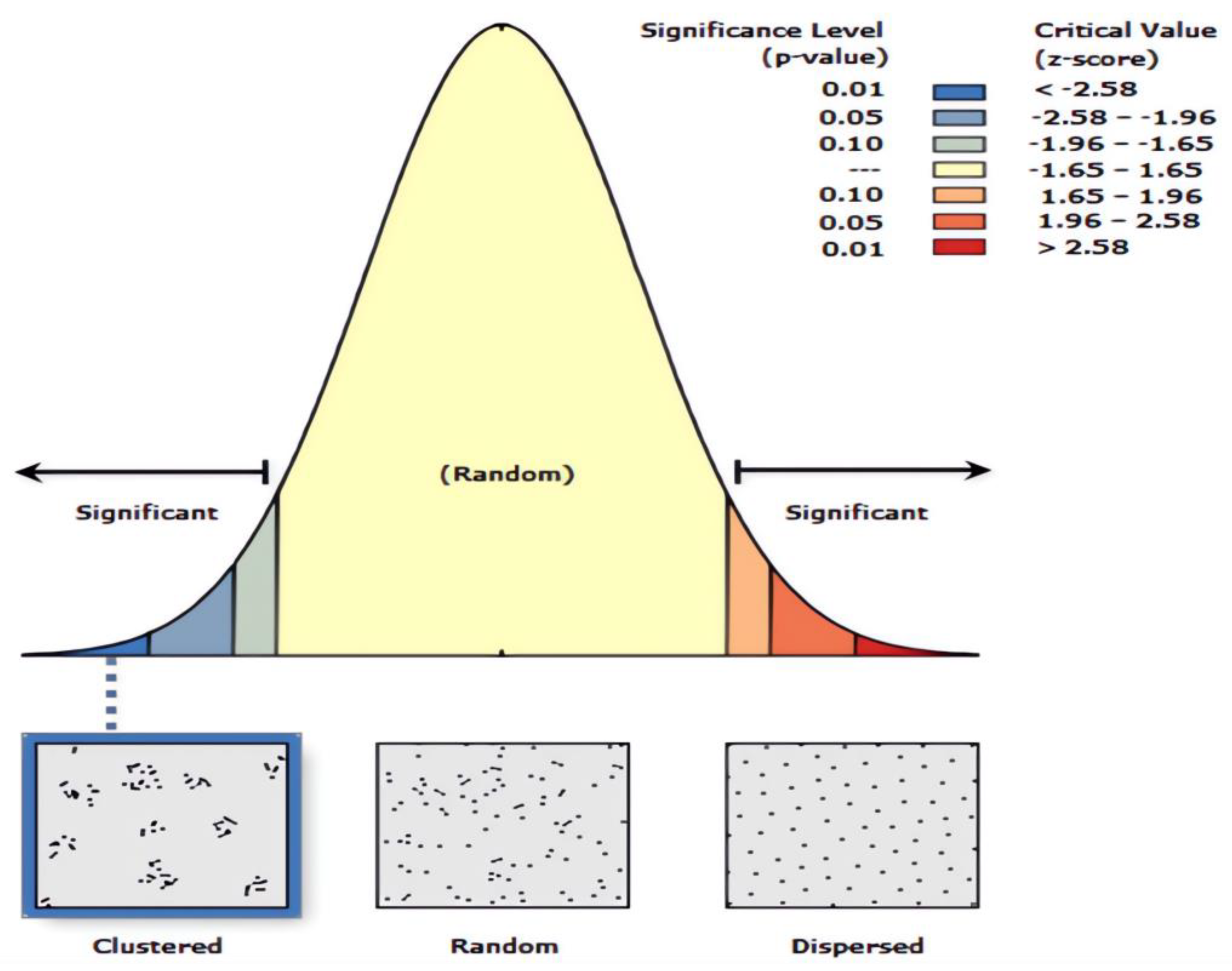
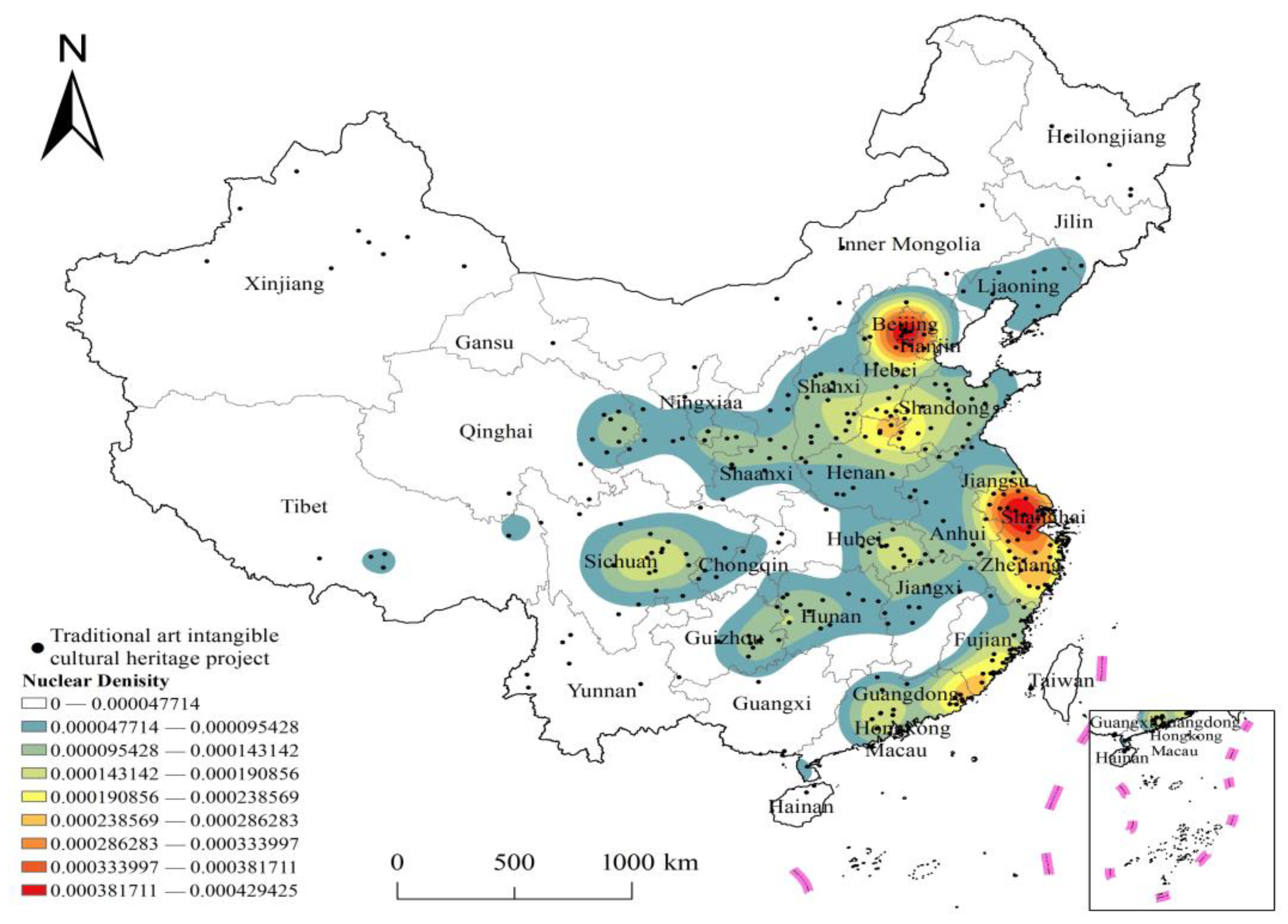
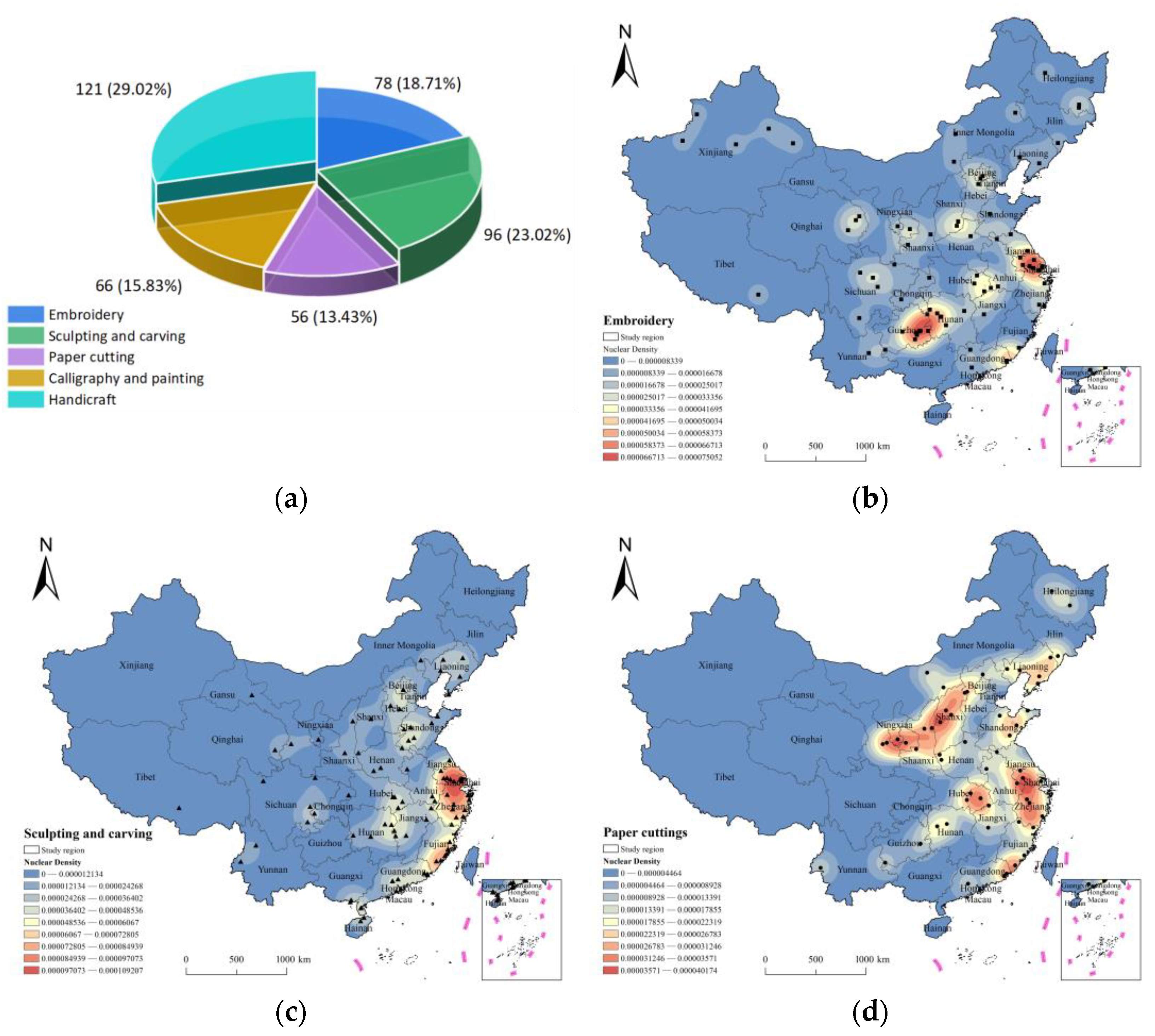
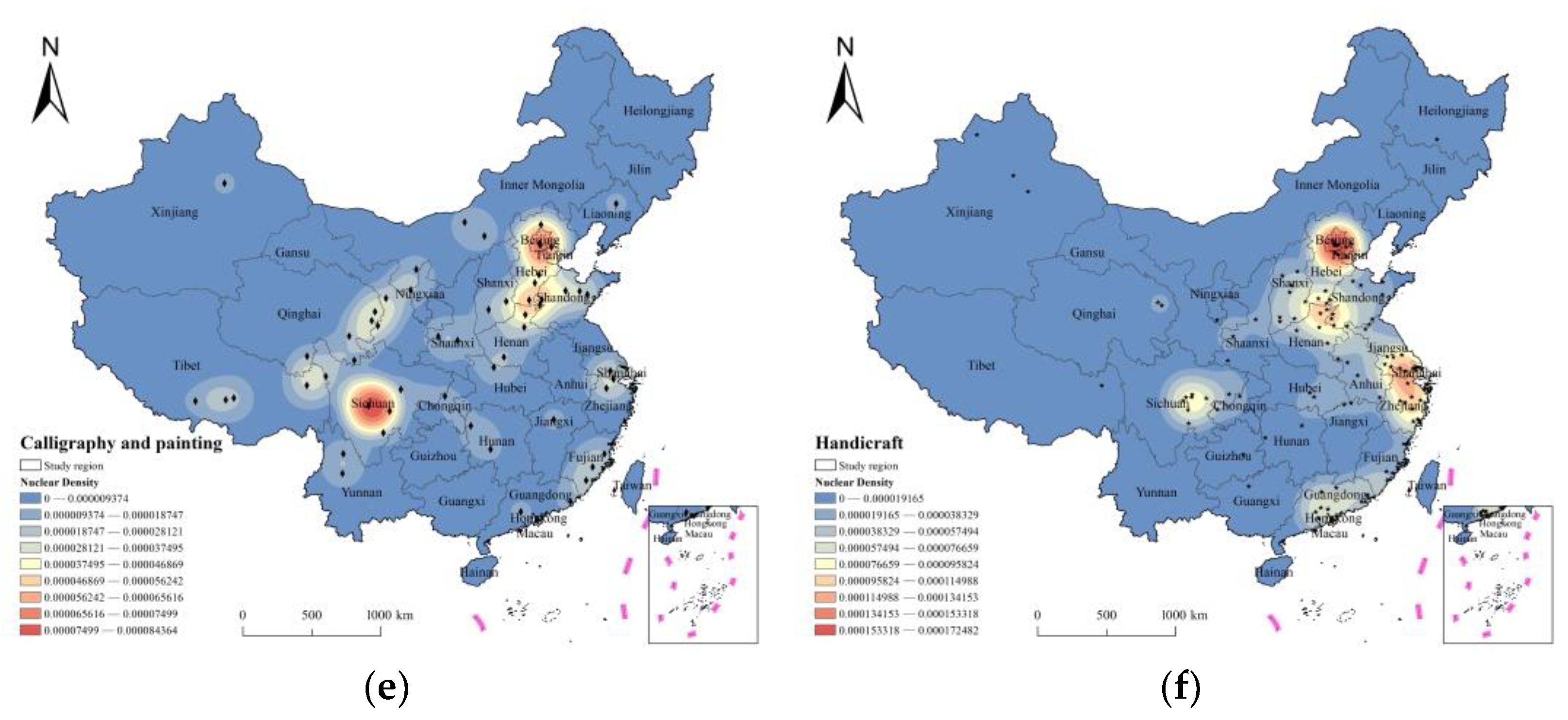

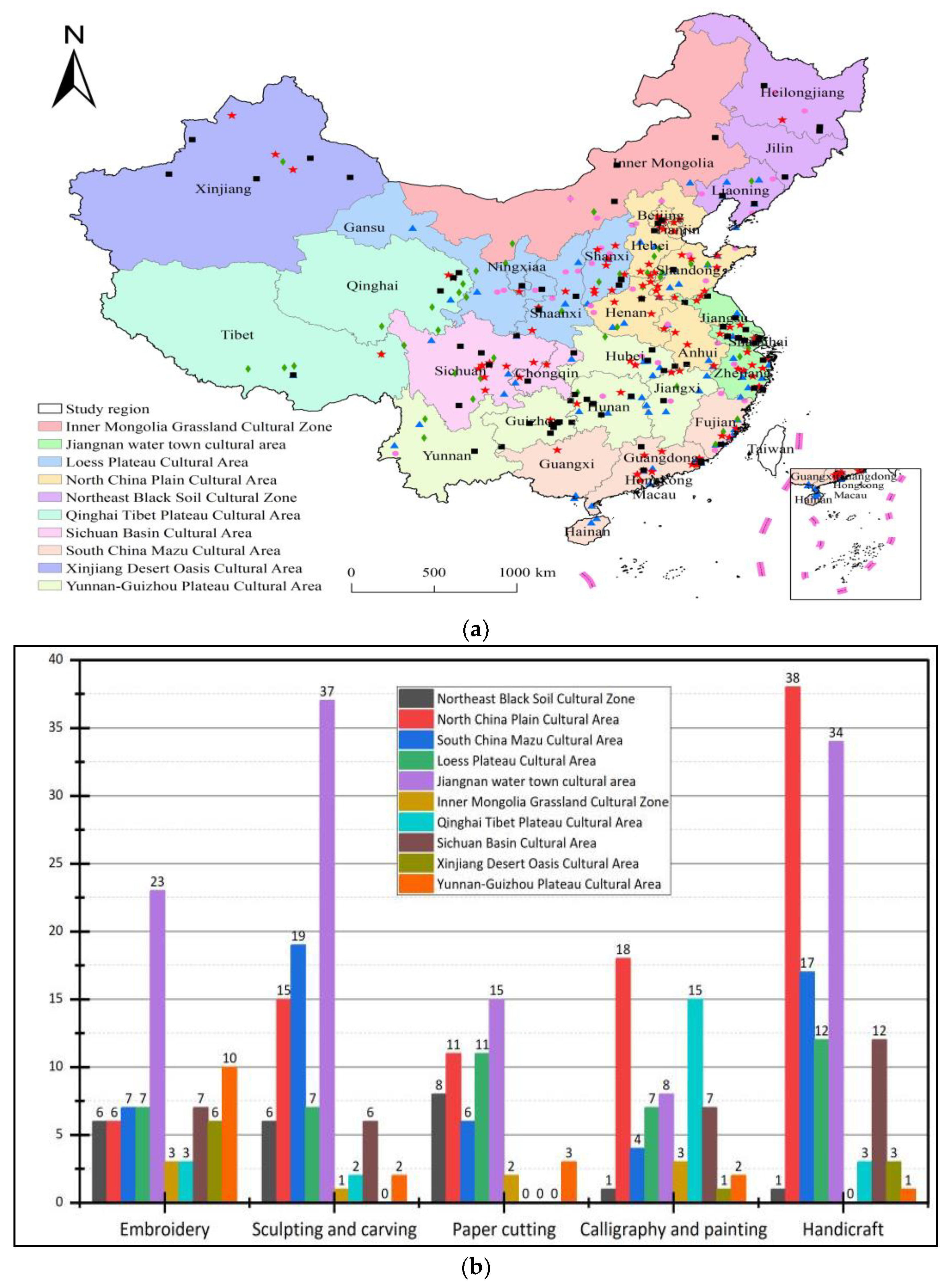

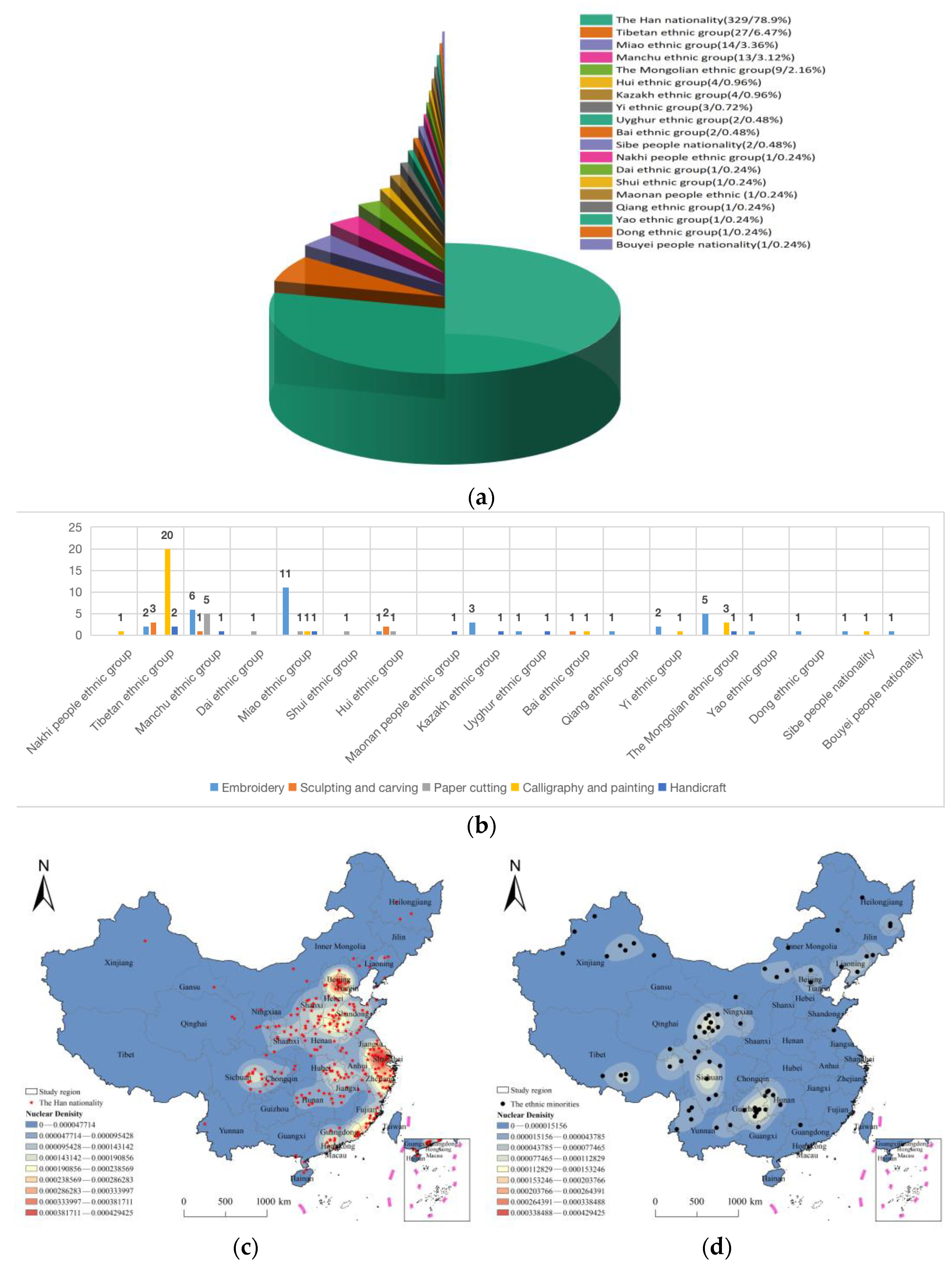
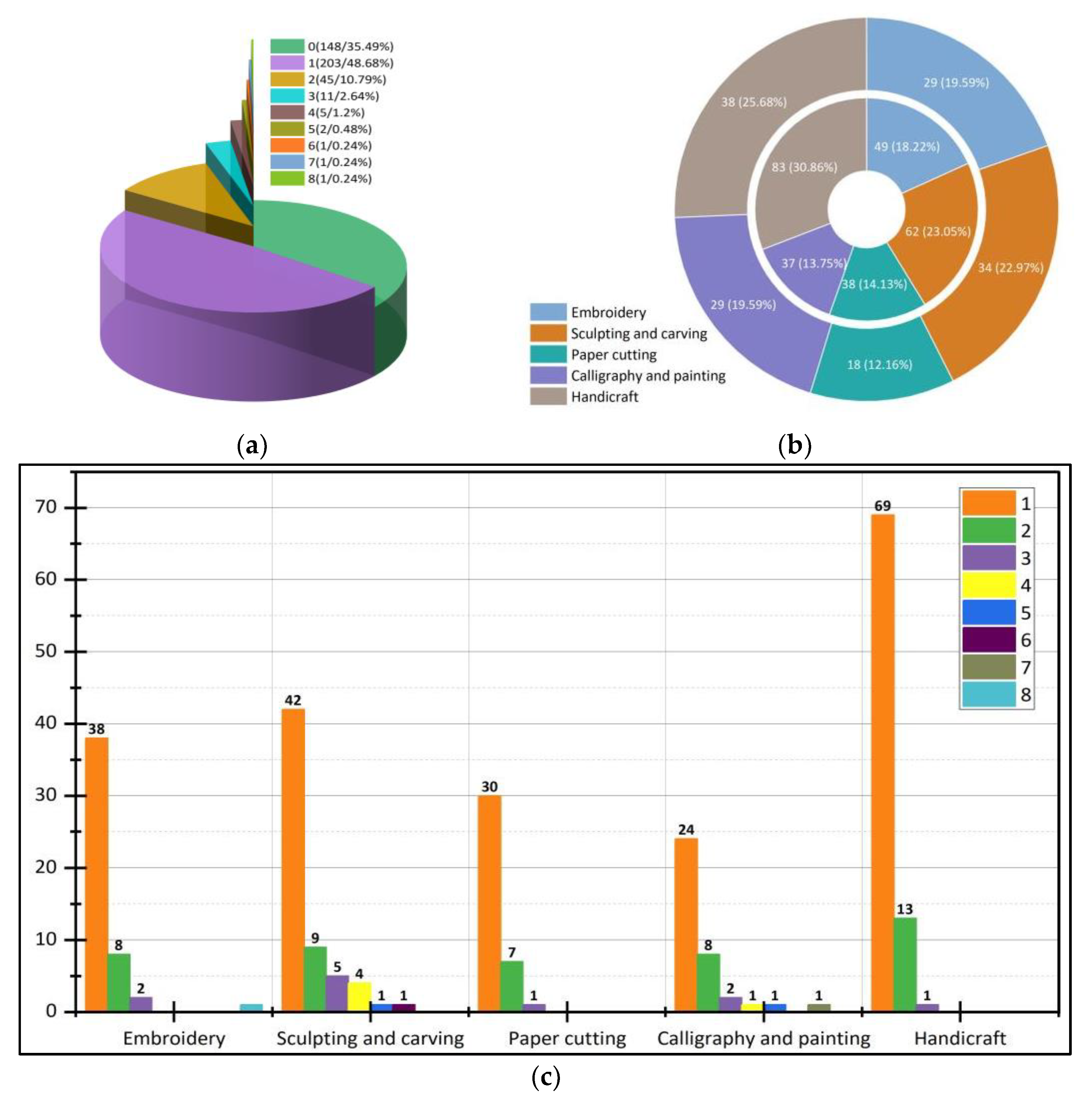
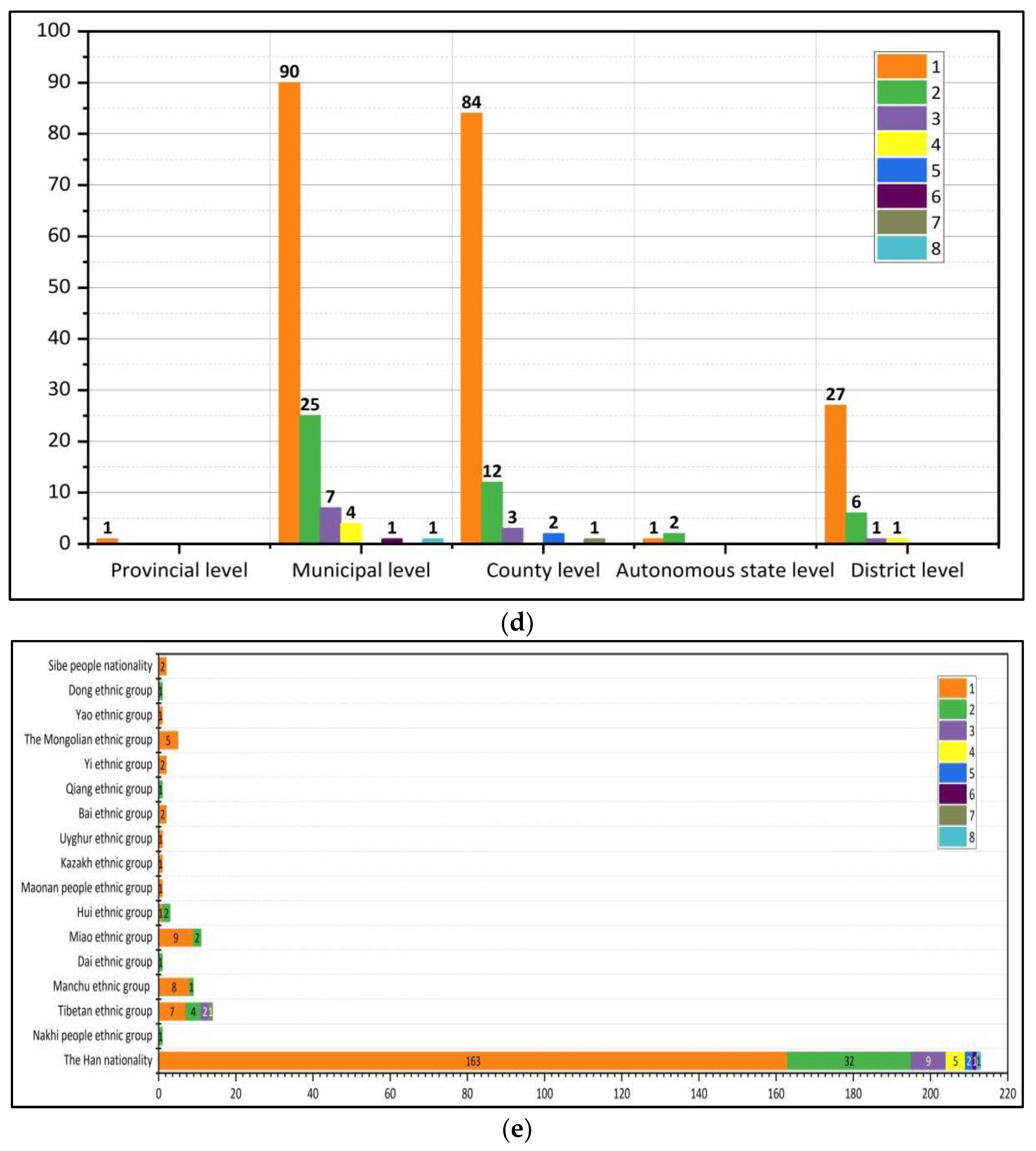

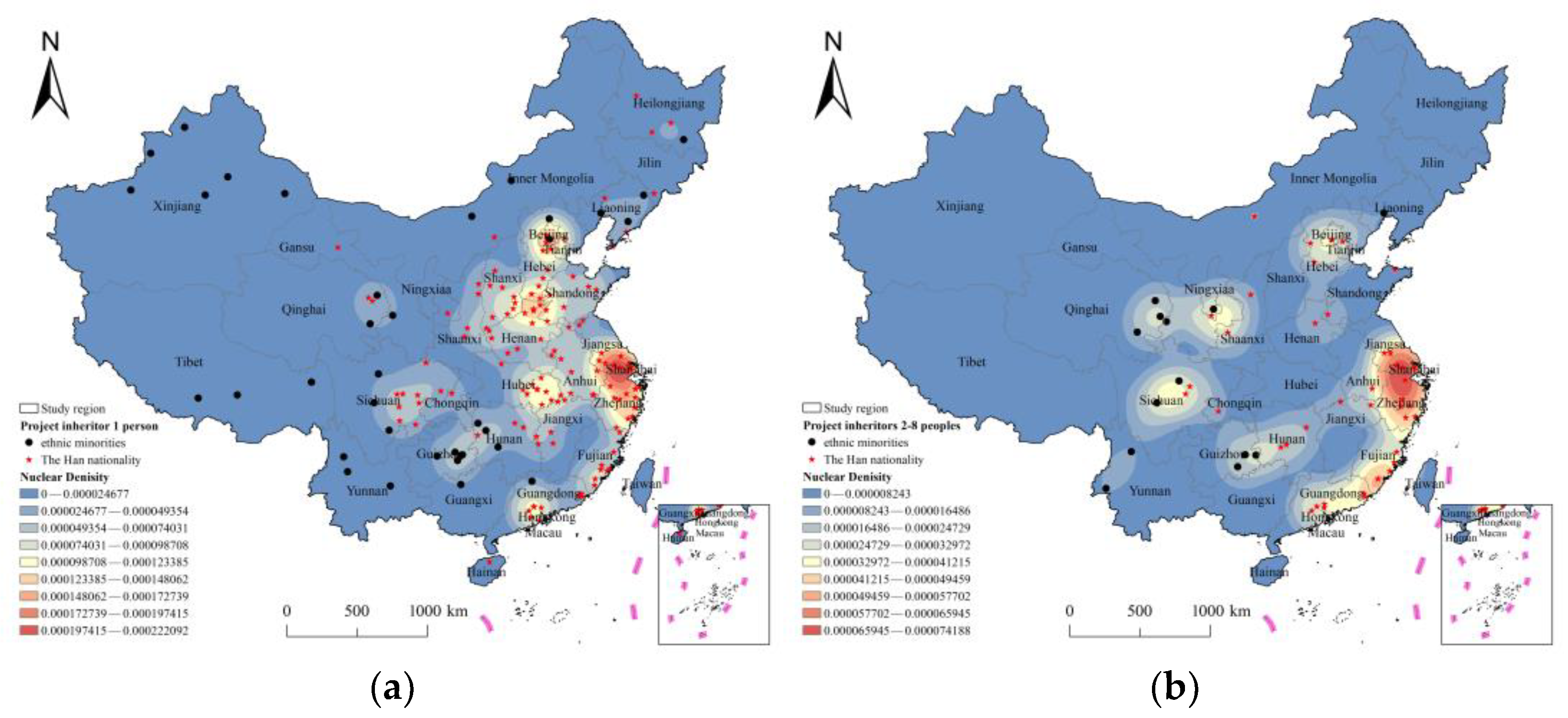
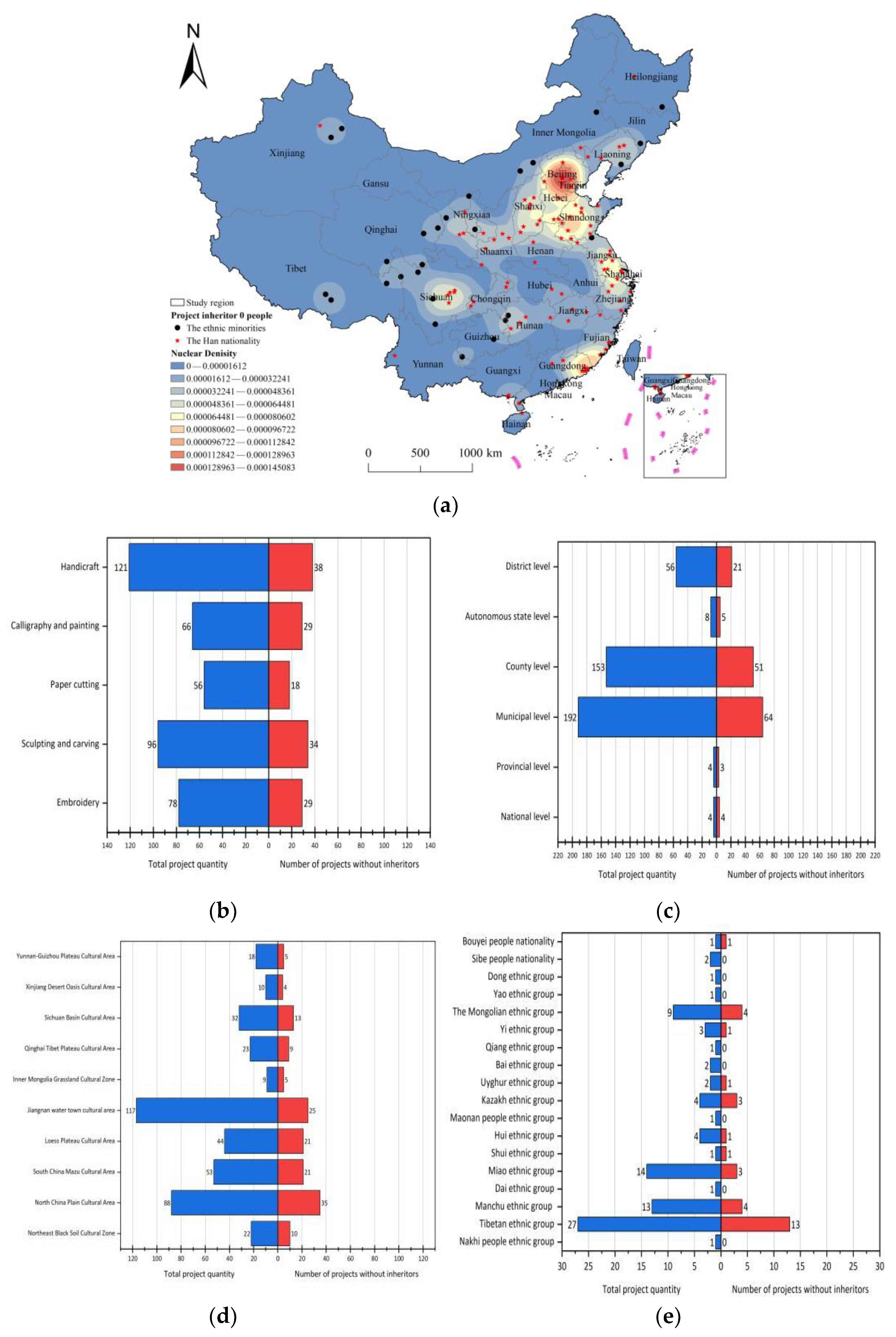
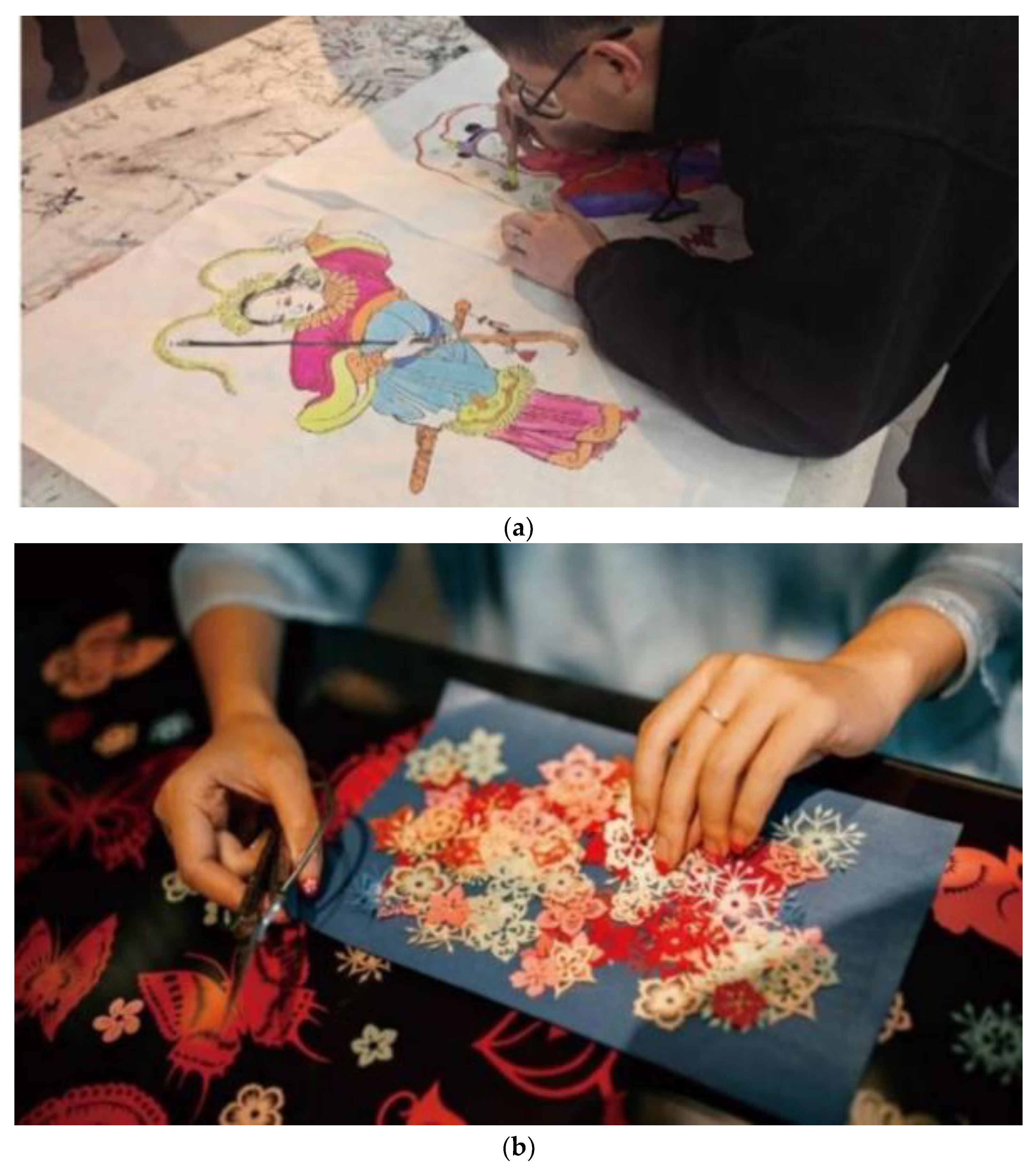
| Spatial Distribution-Type Elements and Content | ||
|---|---|---|
| Distribution-Type Elements | Type Quantity | Distribution-Type Content |
| Classification types of ICHA | 5 | Calligraphy and painting, embroidery, Paper Cutting, handicraft, sculpting, and carving |
| Classification level of ICHA | 6 | Country level, province level, city level, autonomous prefecture level, area level, county level |
| Cultural zone types | 10 | Northeast Black Soil Cultural Zone, Yunnan–Guizhou Plateau Cultural Zone, Inner Mongolia Grassland Cultural Zone, North China Plain Cultural Zone, South China Mazu Cultural Zone, Sichuan Basin Cultural Zone, Xinjiang Desert Oasis Cultural Zone, Jiangnan Water Town Cultural Zone, Qinghai Tibet Plateau Cultural Zone, Loess Plateau Cultural Zone |
| Project provinces | 32 | Anhui, Macau, Beijing, Fujian, Gansu, Guangdong, Guizhou, Hainan, Hebei, Henan, Heilongjiang, Hube, Hunan, Jilin, Jiangsu, Liaoning, Inner, Mongolia, Ningxia, Qinghai, Shandong, Shaanxi, Shanghai, Sichuan, Tianjin, Tibet, Yunnan, Zhejiang, Chongqing |
| Project ethnicities | 19 | The Han nationality, Nakhi people ethnic group, Tibetan ethnic group, Manchu ethnic group, Dai ethnic group, Miao ethnic group, Hui ethnic group, Maonan people ethnic group, Kazakh ethnic group, Uyghur ethnic group, Baiethnic group, Qiang ethnic group, Yi ethnic group, Mongolian ethnic group, Yao ethnic group, Dong ethnic group, Sibe people nationality, Shui ethnic group, Bouyei people nationality |
| Inheritor ethnicities | 17 | The Han nationality, Nakhi people ethnic group, Tibetan ethnic group, Manchu ethnic group, Dai ethnic group, Miao ethnic group, Hui ethnic group, Maonan people ethnic group, Kazakh ethnic group, Uyghur ethnic group, Bai ethnic group, Qiang ethnic group, Yi ethnic group, Mongolian ethnic group, Yao ethnic group, Dong ethnic group, Sibe people nationality |
| Number of inheritors | 9 | 0, 1, 2, 3, 4, 5, 6, 7, 8 |
Disclaimer/Publisher’s Note: The statements, opinions and data contained in all publications are solely those of the individual author(s) and contributor(s) and not of MDPI and/or the editor(s). MDPI and/or the editor(s) disclaim responsibility for any injury to people or property resulting from any ideas, methods, instructions or products referred to in the content. |
© 2024 by the authors. Licensee MDPI, Basel, Switzerland. This article is an open access article distributed under the terms and conditions of the Creative Commons Attribution (CC BY) license (https://creativecommons.org/licenses/by/4.0/).
Share and Cite
Cai, Z.; Cai, K.; Huang, T.; Zhang, G.; Chen, R. Spatial Distribution Characteristics and Sustainable Inheritance Strategies of National Traditional Fine Arts Intangible Cultural Heritage in China. Sustainability 2024, 16, 4488. https://doi.org/10.3390/su16114488
Cai Z, Cai K, Huang T, Zhang G, Chen R. Spatial Distribution Characteristics and Sustainable Inheritance Strategies of National Traditional Fine Arts Intangible Cultural Heritage in China. Sustainability. 2024; 16(11):4488. https://doi.org/10.3390/su16114488
Chicago/Turabian StyleCai, Zhiqiang, Keke Cai, Tao Huang, Ge Zhang, and Ruixi Chen. 2024. "Spatial Distribution Characteristics and Sustainable Inheritance Strategies of National Traditional Fine Arts Intangible Cultural Heritage in China" Sustainability 16, no. 11: 4488. https://doi.org/10.3390/su16114488
APA StyleCai, Z., Cai, K., Huang, T., Zhang, G., & Chen, R. (2024). Spatial Distribution Characteristics and Sustainable Inheritance Strategies of National Traditional Fine Arts Intangible Cultural Heritage in China. Sustainability, 16(11), 4488. https://doi.org/10.3390/su16114488






